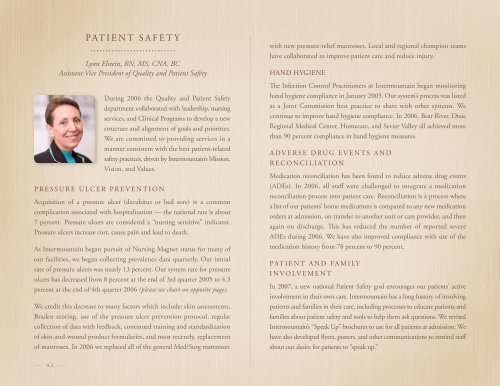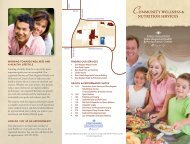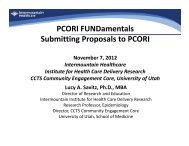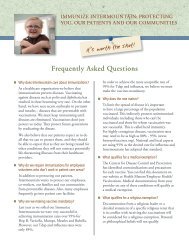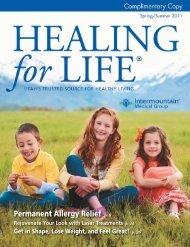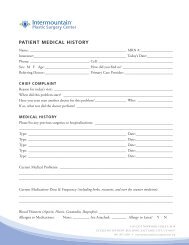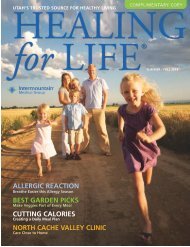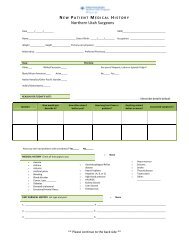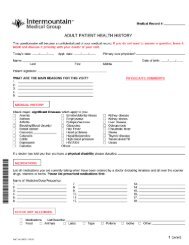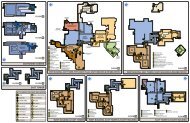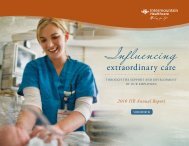Annual Nursing Update - Intermountain Healthcare
Annual Nursing Update - Intermountain Healthcare
Annual Nursing Update - Intermountain Healthcare
- No tags were found...
You also want an ePaper? Increase the reach of your titles
YUMPU automatically turns print PDFs into web optimized ePapers that Google loves.
Lynn Elstein, RN, MS, CNA, BCAssistant Vice President of Quality and Patient SafetyDuring 2006 the Quality and Patient Safetydepartment collaborated with leadership, nursingservices, and Clinical Programs to develop a newstructure and alignment of goals and priorities.We are committed to providing services in amanner consistent with the best patient-relatedsafety practices, driven by <strong>Intermountain</strong>’s Mission,PAT I E N T S A F E T YVision, and Values.P r e s s u r e U l c e r P r e v e n t i o n. . . 4 2 . . .Acquisition of a pressure ulcer (decubitus or bed sore) is a commoncomplication associated with hospitalization — the national rate is about7 percent. Pressure ulcers are considered a “nursing sensitive” indicator.Pressure ulcers increase cost, cause pain and lead to death.As <strong>Intermountain</strong> began pursuit of <strong>Nursing</strong> Magnet status for many ofour facilities, we began collecting prevalence data quarterly. Our initialrate of pressure ulcers was nearly 13 percent. Our system rate for pressureulcers has decreased from 8 percent at the end of 3rd quarter 2005 to 4.3percent at the end of 4th quarter 2006 (please see chart on opposite page).We credit this decrease to many factors which include: skin assessments,Braden scoring, use of the pressure ulcer prevention protocol, regularcollection of data with feedback, continued training and standardizationof skin-and-wound product formularies, and most recently, replacementof mattresses. In 2006 we replaced all of the general Med/Surg mattresseswith new pressure-relief mattresses. Local and regional champion teamshave collaborated to improve patient care and reduce injury.Hand HygieneThe Infection Control Practitioners at <strong>Intermountain</strong> began monitoringhand hygiene compliance in January 2005. Our system’s process was listedas a Joint Commission best practice to share with other systems. Wecontinue to improve hand hygiene compliance. In 2006, Bear River, DixieRegional Medical Center, Homecare, and Sevier Valley all achieved morethan 90 percent compliance in hand hygiene measures.A d v e r s e D r u g E v e n t s A N DR e c o n c i l i at i o nMedication reconciliation has been found to reduce adverse drug events(ADEs). In 2006, all staff were challenged to integrate a medicationreconciliation process into patient care. Reconciliation is a process wherea list of our patients’ home medications is compared to any new medicationorders at admission, on transfer to another unit or care provider, and thenagain on discharge. This has reduced the number of reported severeADEs during 2006. We have also improved compliance with use of themedication history from 78 percent to 90 percent.Pat i e n t A N D F a m i lyI n v o lv e m e n tIn 2007, a new national Patient Safety goal encourages our patients’ activeinvolvement in their own care. <strong>Intermountain</strong> has a long history of involvingpatients and families in their care, including processes to educate patients andfamilies about patient safety and tools to help them ask questions. We revised<strong>Intermountain</strong>’s “Speak Up” brochures to use for all patients at admission. Wehave also developed flyers, posters, and other communications to remind staffabout our desire for patients to “speak up.”


